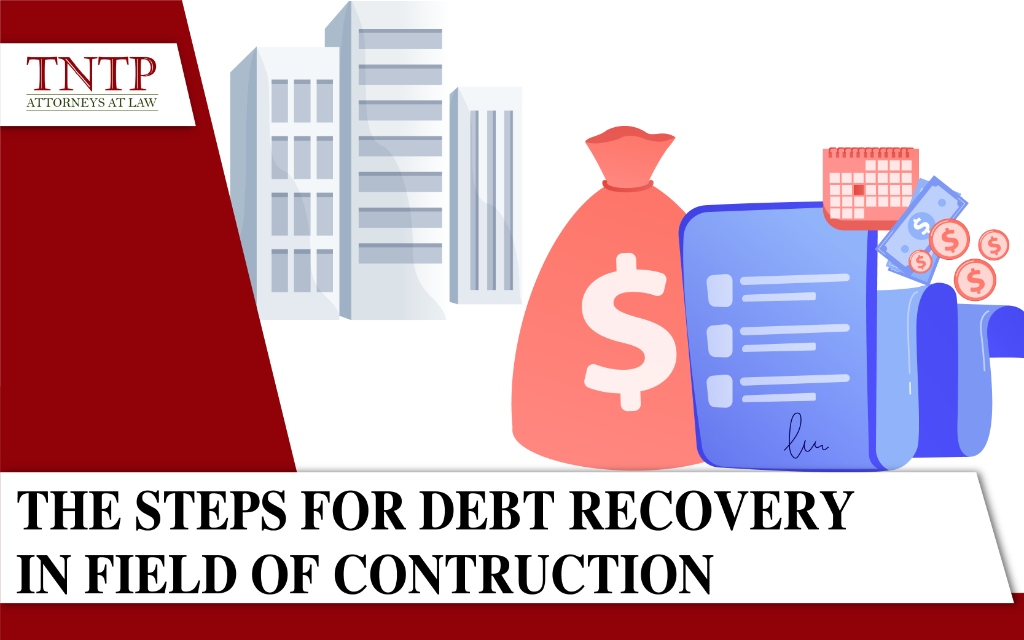The steps for debt recovery in the field of construction

To effectively recover debts, both businesses in general and construction businesses, in particular, need to carry out the necessary tasks following appropriate procedures. In this article, TNTP’s lawyers will share their expertise on debt recovery steps that construction businesses can refer to for their operations.
Step 1: Prepare Documents and Evidence
To efficiently proceed with debt recovery, businesses need to prepare the following necessary documents and evidence:
a) Contracts or agreements signed between the business and the debtor.
In cases where the debt arises from a contract or agreement between the business and the debtor, the business must prepare these documents. The contract or agreement will include content related to penalties for breaches of obligations, compensation for damages, interest rates agreed upon by the parties, and the competent authority to resolve disputes. These contents are crucial and will directly affect the amount that the business requests the debtor to pay, and even the dispute resolution authority if the business intends to initiate legal action to recover the debt.
b) Invoices, delivery receipts for goods and services.
These are documents that demonstrate the quantity of goods and services provided by the business to the debtor, as well as the value of these goods and services. They also indicate the time and place of goods delivery and service provision. These documents aim to illustrate the execution process of the contract between the business and the debtor, as well as determine the outstanding obligations of the remaining debtor. These documents reflect the contract execution process and the agreement’s terms, serving as essential evidence for the debtor’s payment request. Therefore, they are crucial in the debt recovery process and even during the lawsuit phase.
c) Debt reconciliation report
The debt reconciliation report is a document confirming the value of the debt that the debtor is obligated to pay based on the content of the previous contract or agreement. The amount stated in the debt reconciliation report serves as a clear basis for the business to request the debtor to fulfill their payment obligation because, upon entering into the debt reconciliation report, the debtor acknowledges the debt and cannot deny the obligation to repay it. This is a very important document that businesses should consider preparing when conducting debt recovery.
Step 2: Negotiation
During the negotiation phase, the business will contact the debtor through various means, including phone calls, emails, written communication, and even sending representatives to the debtor’s office for direct discussions. The goal of the negotiation phase is to assess whether the debtor is willing to pay willingly. In cases where the debtor is delayed in payment or shows no willingness to pay the debt, the business needs to notify the debtor of its intention to take legal measures such as initiating a lawsuit in dispute resolution authorities to exert pressure on the debtor to make payment.
Step 3: Initiate Legal Action
If the negotiation phase is unsuccessful, the business can proceed with legal action to recover the debt. At this stage, the business will file a lawsuit along with supporting evidence and relevant documents related to the debt with dispute resolution authorities such as the Court or the competent Commercial Arbitration Center.
The objective of this stage is to provide a legal basis for dispute resolution authorities to consider and accept the business’s request to compel the debtor to pay. When dispute resolution authorities accept the business’s lawsuit request, they will issue a legally binding document, either a judgment/decision (for the Court) or an arbitral award (for the Commercial Arbitration Center). These legally binding judgments or awards will be enforceable by law, at which point the competent enforcement authorities will act on behalf of the state’s authority and take necessary enforcement measures to compel the debtor to fulfill the payment.
The enforcement measures at the execution stage are ensured to be carried out in accordance with the provisions of the law, and therefore, the debtor is legally obligated to comply. Therefore, initiating a lawsuit is a crucial step with the highest potential for debt recovery. However, legal action comes with costs and time constraints as stipulated by the law, so businesses should carefully consider it before proceeding to safeguard their rights and interests.
The above is an article by TNTP lawyers on the topic: “Debt recovery steps for businesses in the construction industry.” It is hoped that this article provides value to the readers.
Best regard,



